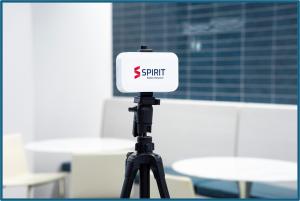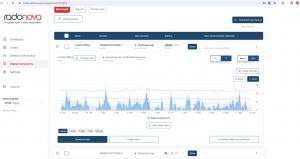The Radonova SPIRIT Continuous Radon Monitor Achieves C-NRPP Approval
The SPIRIT continuous radon monitor (CRM) by Radonova is now listed as a C-NRPP approved device in Canada.
LOMBARD, IL, UNITED STATES, September 11, 2024 /EINPresswire.com/ -- The SPIRIT is a portable continuous radon monitor for use by radon professionals that measures radon in real time, stores the data in the cloud, and transfers the data wirelessly. Users have access to radon results through Radonova's online portal where the data can be easily downloaded. The SPIRIT Radon® monitor also includes sensors for air pressure, temperature, humidity and movement/tampering as well as a 60-day rechargeable battery.Compact and easy to use, the SPIRIT can be placed in a home, school, or workplace and the user can view real time results from a remote location such as their office computer. Reports can then be generated by selecting the specific date and time intervals needed. This provides a key benefit over other industry radon monitors that base output on the average of 12 hours of measurement or longer.
Follow-up Measurements in Schools and Workplaces
The SPIRIT can improve the efficiency in satisfying Health Canada’s recommendation for a seven day follow-up measurement in schools and HVAC controlled buildings where long-term radon results are above the guideline of 200 Bq/m3. By having the long-term radon results, such as those measured by a Radtrak3 alpha track detector, the SPIRIT software can automatically calculate the estimated annual radon average during working hours. The software first calculates the factor of radon content during working hours (or school occupied hours) and also for the entire measurement period and then multiplies the factor by the previously measured annual average. "This eliminates the need for tedious manual calculations by the user," says Zan Jones of Radonova, Inc.
Optimizing Building Ventilation
Time-controlled ventilation in schools and office buildings can have a substantial effect on reducing radon levels. When a ventilation system is running at capacity, the radon gas is diluted to lower levels, but when the ventilation system is off, radon levels can increase. The SPIRIT radon monitor measures radon levels in real-time. When combined with an energy management system, the SPIRIT can be used to help schedule the times to turn the ventilation on and off to achieve the safest radon levels.
Post-mitigation Radon Testing
Once a home or building has tested high for radon and a radon removal/mitigation system has been installed, a post-mitigation radon test using the SPIRIT continuous radon monitor for at least 48 hours can provide a rapid indication of the radon mitigation system effectiveness. This should then also be followed up with a “long-term radon test during the first winter season following installation of the radon mitigation system,” according to the C-NRPP.
Remote Monitoring of Schools, Universities, and Workplace Campuses
Multiple SPIRIT radon devices can be monitored from a common dashboard. Schools, universities, and large office complexes often have several buildings within a campus. With the SPIRIT, facility managers can view radon levels in all buildings at once by logging in to the Radonova online portal. Further integration can be done with the help of APIs. Measuring different points with the SPIRIT throughout a building can also help with developing a thorough radon mitigation plan.
24-hour Facilities
Call centers, hotels, medical facilities, distribution centers, and retail establishments can be staffed 24/7. Night shifts often have fewer staff members and less activity. Real-time radon measurement with the SPIRIT continuous radon monitor can provide an accurate display of the radon levels during day and night shifts. This provides those responsible for protecting the indoor air quality with the data needed to ensure employees are not exposed to elevated radon on the job.
Radon is an odorless and colorless gas that is released during the natural decay of uranium in soil and rocks around homes, schools, and workplaces. It enters buildings through cracks and other openings in the foundation, such as sump holes or drains. Energy efficient homes and buildings trap radon inside where the gas decays into harmful radioactive atoms that get caught in the respiratory tract when people breathe. This can damage the DNA of cells lining the lungs and lead to lung cancer. Radon is the number one cause of lung cancer in nonsmokers and the number two cause of lung cancer in Canada and the United States.
About Radonova
Radonova is the laboratory of choice for numerous government radon surveys, as well as other public, and private sector large-scale measurement contracts around the world. A truly global laboratory, Radonova is active in over 80 countries and has performed millions of measurements. Contact Radonova at 331-814-2200.
Zan Jones
Radonova, Inc.
+1 331-814-2200
email us here
Visit us on social media:
Facebook
X
LinkedIn
YouTube
Legal Disclaimer:
EIN Presswire provides this news content "as is" without warranty of any kind. We do not accept any responsibility or liability for the accuracy, content, images, videos, licenses, completeness, legality, or reliability of the information contained in this article. If you have any complaints or copyright issues related to this article, kindly contact the author above.



